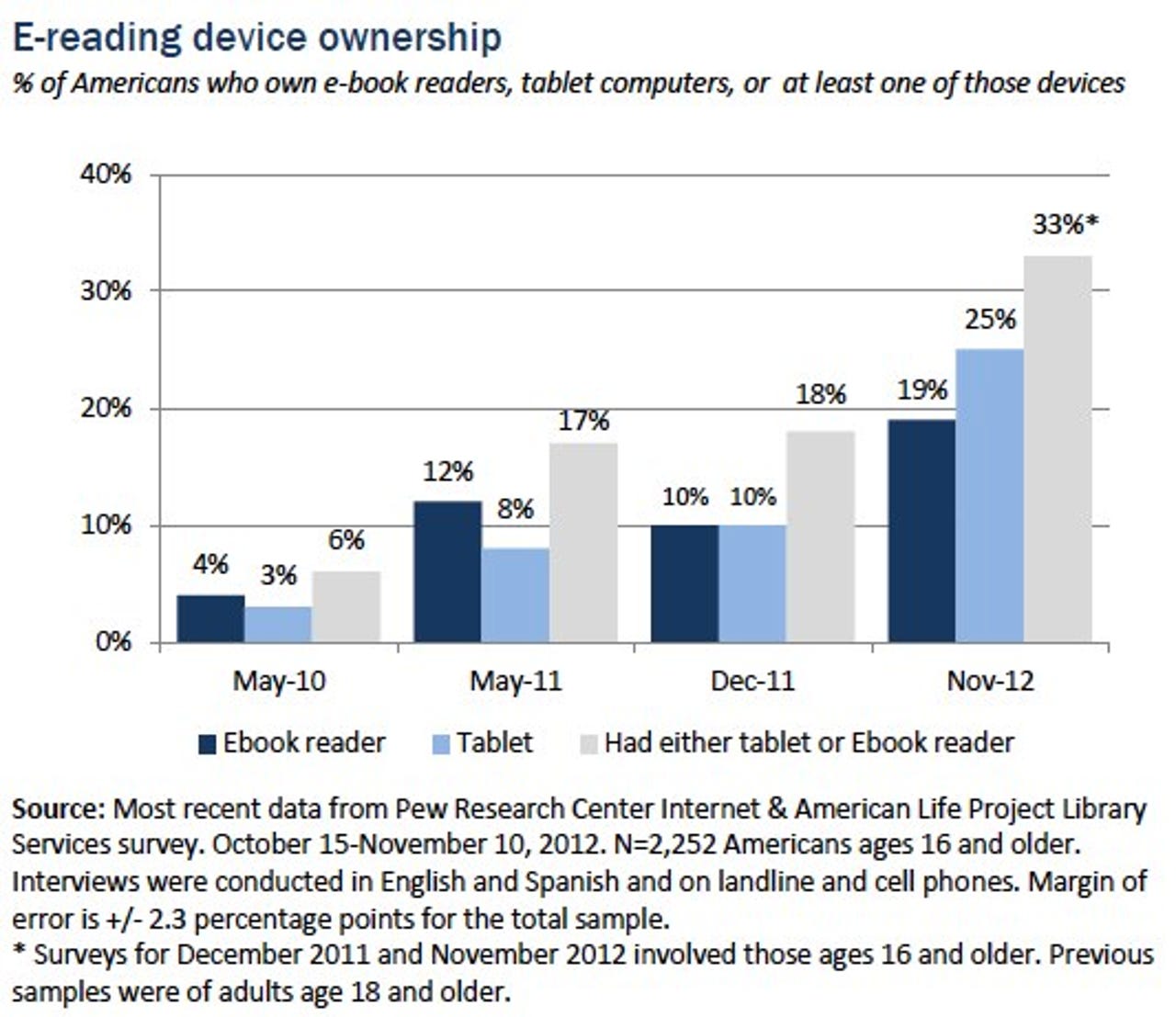Good-bye books, hello e-books


Readers, it’s time to turn a page. In a December 27, 2012 report entitled, "E-book Reading Jumps; Print Book Reading Declines," the Pew Research Center found that "the number of those who read e-books increased from 16% of all Americans ages 16 and older to 23%.” At the same time, the report says, the number of people who read printed books in the previous 12 months “fell from 72% of the population ages 16 and older to 67%."
It's not a sharp decline. The survey of 2,252 Americans (ages 16 and older), found that 89% of the book readers had read a printed book (or 67% of all those ages 16 and older). At the same time, 30% of the book readers said they had read an e-book, which translates into 23% of all those ages 16 and older. An April Pew research project showed that "in mid-December 2011, 17% of American adults had reported they read an e-book in the previous year; by February, 2012, the share increased to 21%."
Who are these readers? In the April 2012 report, Pew researchers stated:
Those who have taken the plunge into reading e-books stand out in almost every way from other kinds of readers. Foremost, they are relatively avid readers of books in all formats: 88% of those who read e-books in the past 12 months also read printed books. Compared with other book readers, they read more books. They read more frequently for a host of reasons: for pleasure, for research, for current events, and for work or school. They are also more likely than others to have bought their most recent book, rather than borrowed it, and they are more likely than others to say they prefer to purchase books in general, often starting their search online.
The people who read e-books are also, to no surprise, all owners of either a tablet computer or e-book reading device. "25% of Americans ages 16 and older own tablet computers such as iPads or Kindle Fires, up from 10% who owned tablets in late 2011" says the report; And in late 2012, "19% of Americans ages 16 and older own e-book reading devices such as Kindles and Nooks, compared with 10% who owned such devices at the same time last year." Put it together, and 33% of adult Americans now own an e-book reader or tablet.
The vast majority of users, whether they use a low-end Kobo Touch eReader or a Samsung Galaxy Note 10.1, are also Android users. The Apple iPad is the only non-Android based tablet used by many e-book readers. Though, of course, many of these users never give a thought to the operating system that runs their device. As long as they can comfortably read the latest Lois McMaster Bujold novel on it, they don’t care about the ones and zeroes that make their reading possible.
E-book readers are well educated. Those most likely to read e-books include those with college or graduate degrees, those who live in households earning more than $75,000, and those whose ages fall between 30 and 49, according to the report. In short, financially successful people tend to be readers – and can afford the devices.
Libraries, according to Pew Research, have also picked up on this trend. While relatively few readers use libraries for e-books, only 5%, "There is growing public awareness that the vast majority of public libraries now lend e-books. In the entire population of those ages 16 and older, the number who are aware that libraries offer e-book loans increased from 24% last year to 31% now."
Digging into the hardware of e-book reading, Pew Research found that while more and more people are using both dedicated e-readers, such as the Kindle and Nook, higher-powered Android tablets, such as the Amazon Kindle Fire, Nook Tablet HD, and Nexus 7 are gaining in popularity over low-end e-readers. In November 2012, tablet users formed 25% of the e-reader population compared to 19% using dedicated e-readers.
Some people, including ZDNet readers, still maintain that dedicated e-reader devices are going to be with us for years to come. Pew's data, and my own experience, lead me to believe that, as prices for low-end tablets continue their steady march downward to the $99 mark, dedicated e-readers will soon disappear from the market.
What won't disappear are e-books and e-book apps. The real question is how long will physical books last as a mass-market item. And that is speaking as someone who loves books, whose idea of “scaling back” on my personal library was to reduce the bookshelves to hold a mere 6,000 books.
Sure, I love books., chances are you love books too. But, I also love newspapers, and that hasn’t kept them from dying off. I also love magazines, but the last print issue of Newsweek, once one of the great newsweeklies, came out this week.
I can read the writing on the wall. The days are numbered for physical mass-market books —even if that number isn’t a small one. Sure, some books, newspapers, and magazines will live on. But, horses lived on after the arrival of the car, too; you just don't see them very often anymore. The same fate awaits physical, paper-based books.
Related Stories: